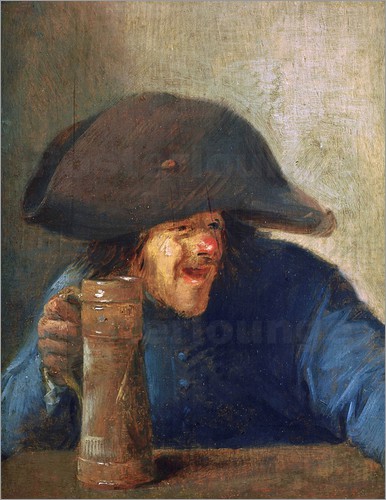
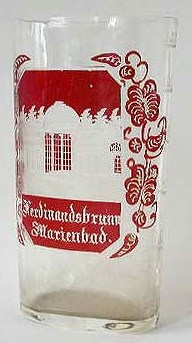
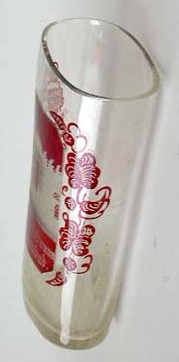
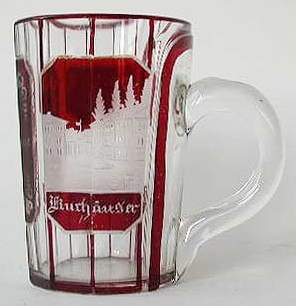
Spa glasses / cups / beakers – Small glasses, cups and beakers, mostly found with ruby-stained clear glass and a cut-to-clear scene, used for drinking the health waters of and at the spas. Old Germany had 100’s (if not 1000’s) of spas. Most all have engraved scenes of the (named) spa’s buildings. A very few that have measuring scales on them were for daily use in “taking the water.” Communal beer steins are much larger. Shown above: [Top] A pocket beaker that is oval at the top and small enough to carry in a pocket and used when needed. [Bottom] Spa cup (mug) with handle. Both Bohemian, Circa 1860-80.
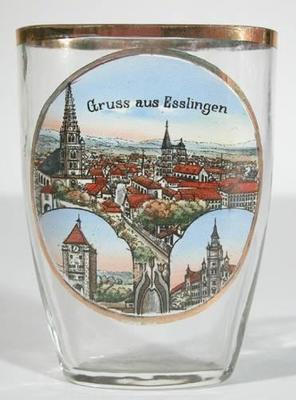
▲A clear blown glass spa cup, PUG . ” Gruss aus Esslingen.” C. 1900Modern version in porcelain with date purchased.
Spanish Fayence steins – See Fayence, Spanish
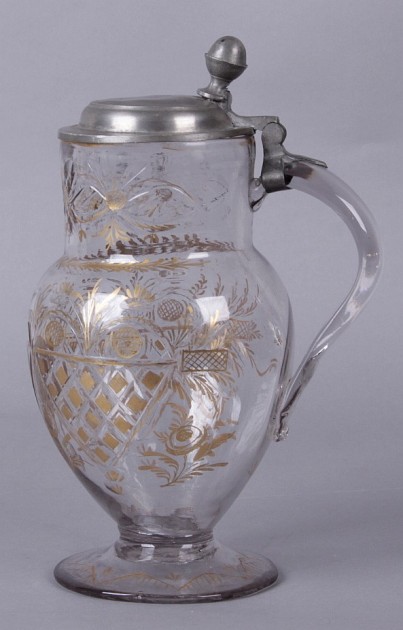
Spanish, other drinking vessels – Glass steins – Above is a very rare one liter Spanish glass stein. This is mouth blown with the heavy gold leaf applied onto the engraving that this firm, located in San lldefonzo, is noted for. This stein is Circa 1775 yet maintains about 90% of its applied gold leaf. [FWTD]
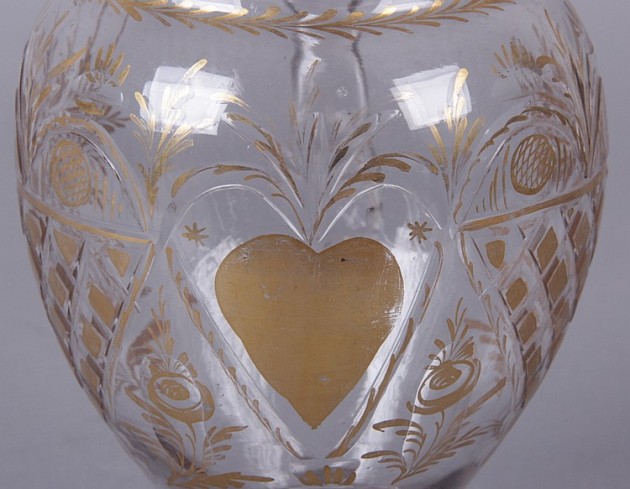
There are very few collectable Spanish drinking vessels as most Spaniards drank wine years ago. But there is a variety of those vessels should one decide to have a sub set. Here are a few I have seen along the way:
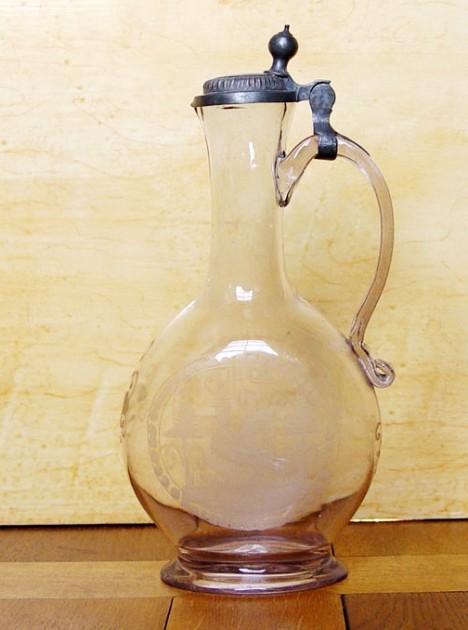
Above ▲ A Spanish glass 1700’s wine / beer server, it was called Dutch when a seller from the Netherlands tried to sell it. Probably more saleable that way!
Spanish – other types of drinking vessels; most found will be mugs!
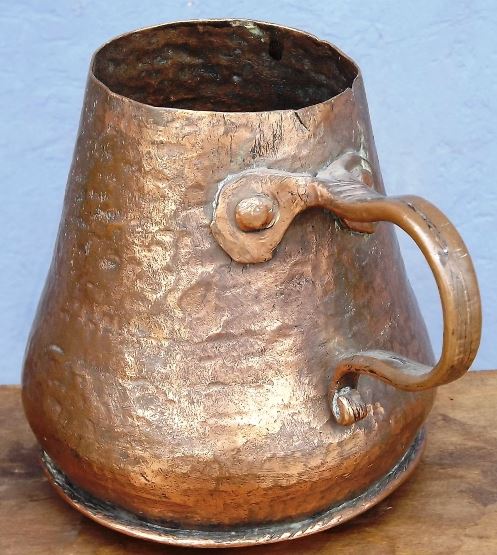
A very solid copper wine server with minimal finishing .They didn’t use these for beer so much as thin wines such as Sangria. The style of handle attachment to the body is very close to 1700’s Arabic. / Ottoman Empire.
. 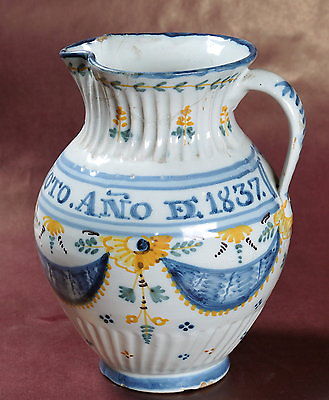
A Spanish Fayence wine pitcher dated 1837. A Nice looking addition to any collection
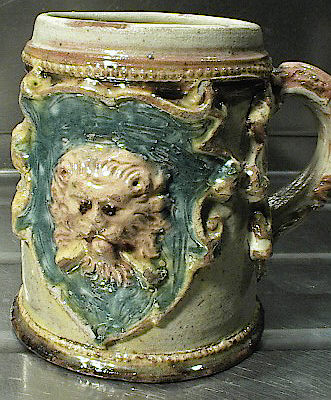
Spanish majolica (lead glaze) beer mug with molded and applied reliefs on the cartouches of Leon (Lion) and Castile (Castle.) 5 inches high. Circa late 1800’s. [FWTD]
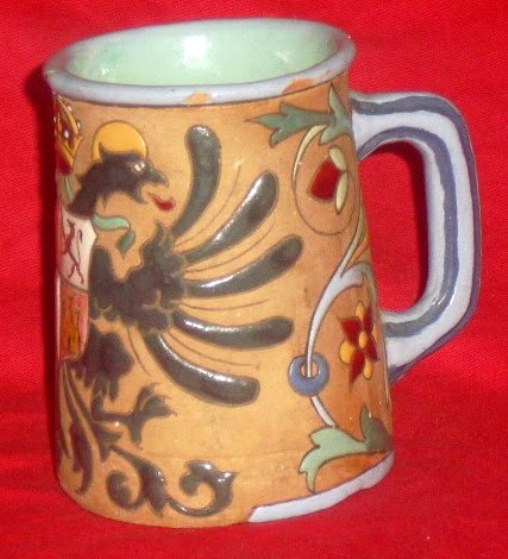
Spanish majolica with the castle and lion on the larger Royal Eagle Arms.
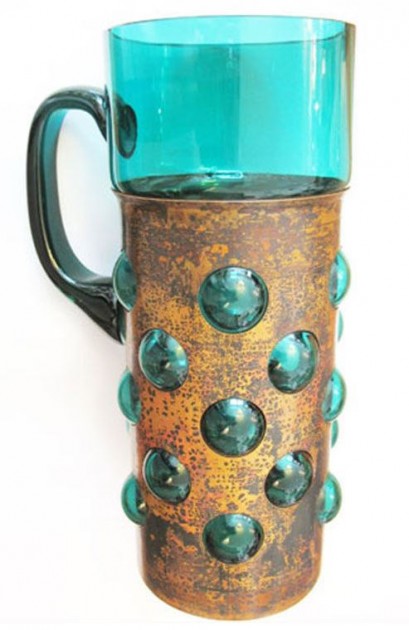
Glass beer mugs with protruding bulges . out of the brass body are amply found.
. 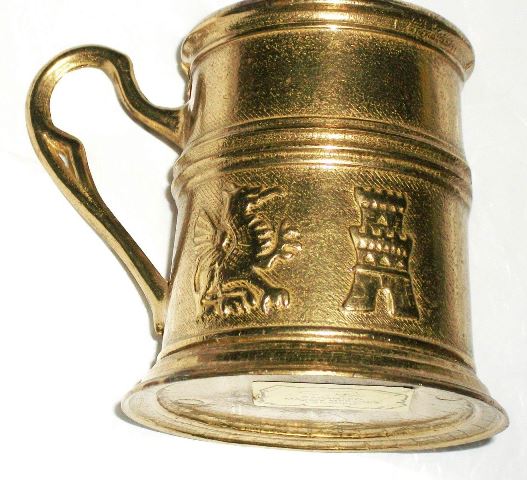
New heavy copper mug again with the castle and lion of Spain in relief
.
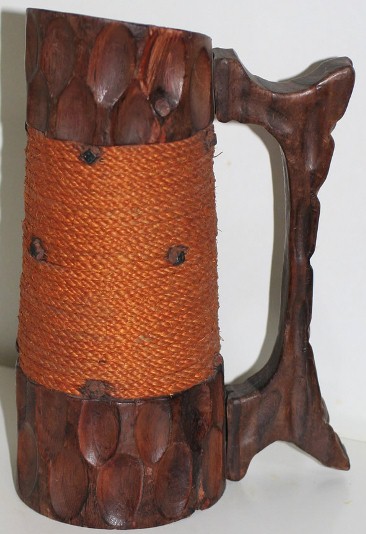
▲ Carved Spanish Wooden drinking vessel. Most are mugs and have large pieces of the body or handle cut / ground out of them, I have never seen any wooden steins [YET]
Spatter -ware steins – see: Baked enamel steins.
Spelter – So called “pot metal.” Mostly any article that is molded and made mostly of zinc (95 to 99%). Many found with a bronze coating such as in the inserts on old glass stein lids. Many statues of the 1800’s were made of spelter. It is a soft metal and easy to break, and not many steins are made of Spelter with out being alloyed with another metal. Also called Whitemetal.
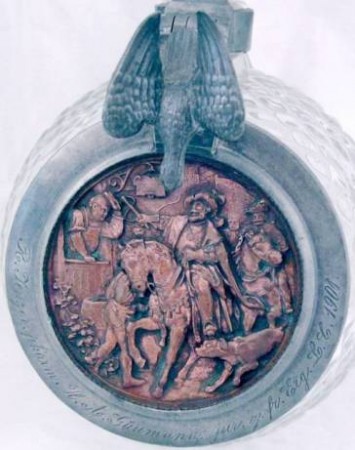
And don’t clean these lids with anything harder than soap and water!
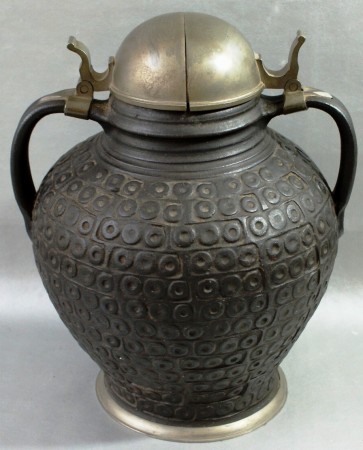
Split Lidded Steins – Pretty much self explanatory with the photo. These are not the same as “Double Lidded Steins” which have a full lid on each handle and are made to sit on top of each other. Shown: A split lidded stein / server designed (made?) by Karl Hentschel. (Krug maker? )
Spinning — The production of hollow wares on a spinning lathe by means of forcing a disc of rotating silver, Britannia or other metal up around a previously hand-turned hardwood head, with a long-handled steel-headed tool, until it has taken its likeness. Known since ancient times, but popular since the early 19th century. Used for later “Old Sheffield Plate” vessels which are seamless.
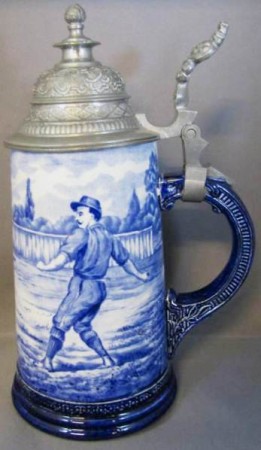
Sports steins – See specific sport by name. The most popular sports in the German area during the golden age of stein production were; Bowling , target shooting (Schützenfest), football (soccer), golf, bicycling, rowing (skulls). rugby. Shown ▲: Baseball. German made, .5 liter porcelain stein with no lithophane. Circa 1875. It does look like a Lenox but is not. See: Soccer
Spread eagle – [1] A term used to describe a stein’s thumblift or finial when the Eagle’s wings are outstretched and not swept back on its body. The German Imperial Eagle has been displayed as thumblifts with wings [a] stretched way out and [b[somewhat back towards its body but not all the way. It must be wearing its crown to be considered Imperial.
photo missing
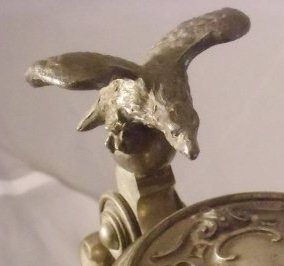
A version used up to the Pranco -Prussian War of 1870 – 71.
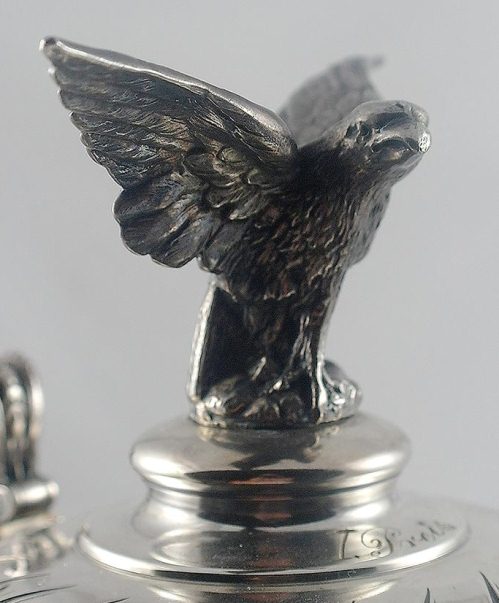
A “Spread” winged eagle used as a finial on an all .800 (German) silver stein
. 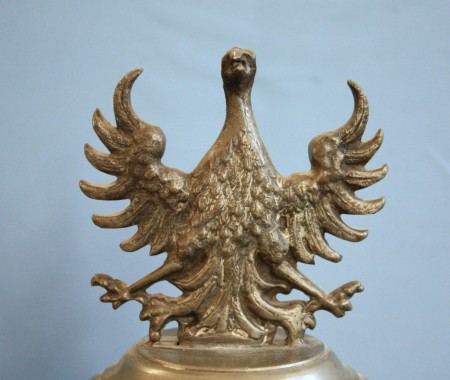
\
This “Spread Eagle” is the old Polish Eagle and can be found on some of the very large pewter serving steins made by the Weygang family. For more info on this maker see: http://www.steveonsteins.com/future-4-the-famile-weygangs-steins-and-servers-1-2
▼A version about 1870, right after the Franco – Prussian war
▼A version used on Reservist steins, as well as others. C. 1900 – 1913
.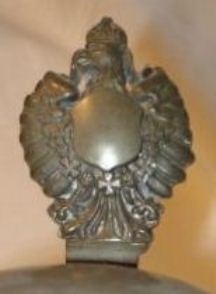
Flattened relief, also seen after 1871
[2] There is at least one other meaning that I am familiar with and if anyone has seen the play or the movie: “Chicago,” they will know what that is! Check out the u-tube version of CHICAGO’S: “CELL BLOCK TANGO” (ALSO CALLED “HE HAD IT COMING”; with Catherine Zeta-Jones singing and dancing, Watch and listen to: http://www.youtube.com/watch?v=TYmMagkfjfI (the first segment)
Staghorn; steins, mugs, servers – Drinking vessels made with handles from deer antlers; “WELL THEY LOOK LIKE ANTLERS.” Most were made from an early resin, for uniformity on mass produced items. Lots of times the applied “staining” has worn off! Most popular are the wooden two handled mugs, some with brass tags having sayings on them. See: http://www.steveonsteins.com/in-the-near-future-2-1-2 Shown ▲: A small copper serving pitcher, most likely from Germany / Austria. Circa 1870, based on its wear.
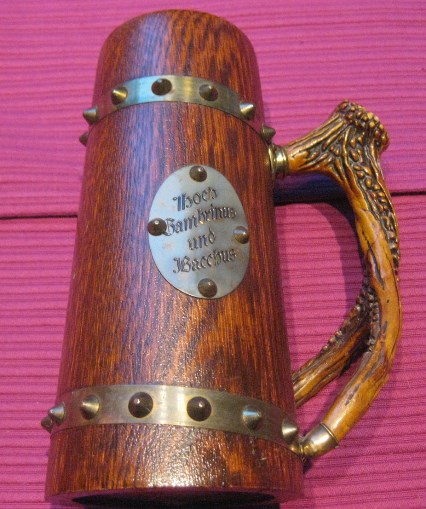
Same fake antler used on this wooden mug. I’m wondering if there was only one supplier of these antlers as they are just about standard in appearance.
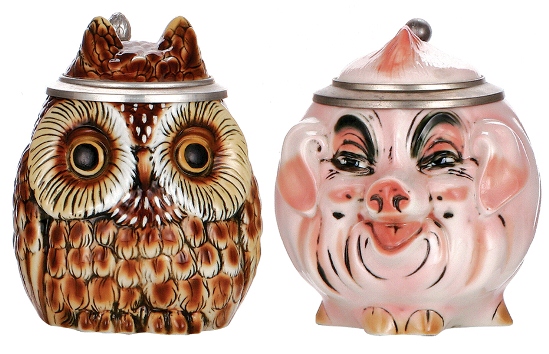
Stahl, Albert – Maker of more modern porcelain character steins. For firm’s history see: http://www.steinmarks.co.uk/pages/pv.asp?p=stein1
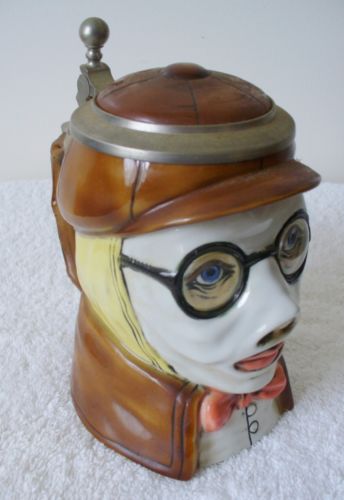 Stahl No. 1437 copy of a Chauffeur’s head.
Stahl No. 1437 copy of a Chauffeur’s head.
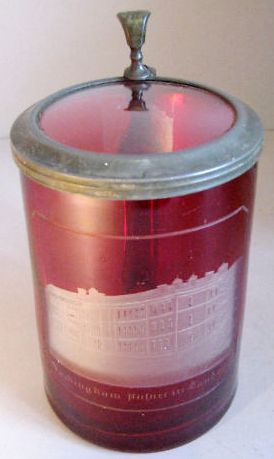
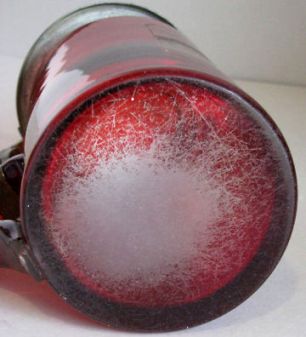
Stained, ruby color – Steins with an applied ruby stain, then muffle fired, then the glass stein is ready to engrave. Shown: Engraved (mostly called cut to clear) with a scene of Buckingham Palace, London. German made, Circa 1850. “Shoehorn” thumblift.
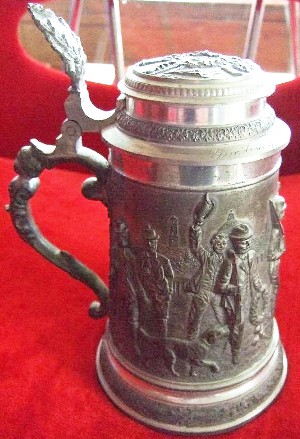
“Stained” pewter steins – A misnomer as it is not stained but chemically treated with a very mild acidic solution. It is done for contrast but I think it distorts the details of the relief. They have been doing this since right before the 1900’s, and once on the body the staining will not come off unless one uses muriatic acid. NOT RECOMMENDED!
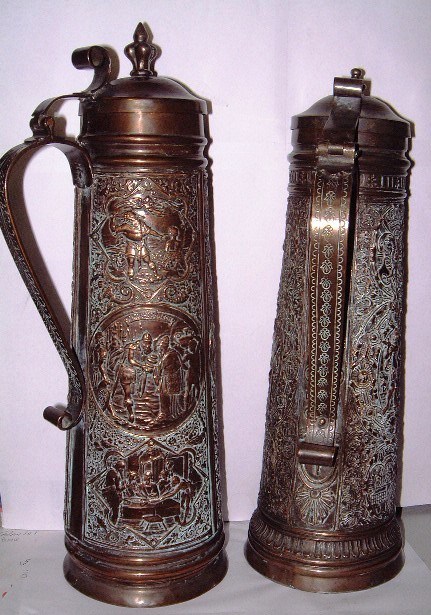
“Stamped” / Pressed (metal) – The mechanical production (since Ca. 1820) of ready-made parts in quantity, complete with their decoration, by the use of hard steel dies cut in reverse to the required pattern. Also called Stamping which is also incorrect. Stamped borders, strapwork, etc., used from the 16th century, were hand-hammered from the back, also using hand-cut dies. Shown ▲: A pair of “Pressed” copper beer steins, Circa 1890-1910, these are copies of 1500’s Siegberg pottery styles. The white inside the lines is dried polish; all one needs to clean it is an old tooth brush and a little” Windex.” Also See: “Embossing “—
Stamps – (Showing steins and other drinking vessels) – A sub set of stein collecting. (Also postcards showing steins and gnomes!)
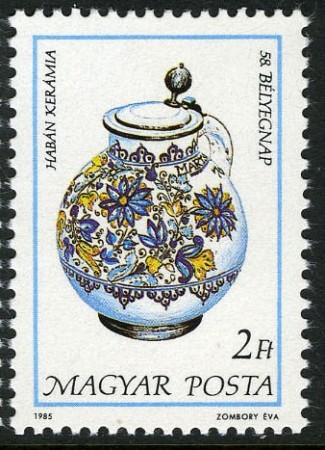
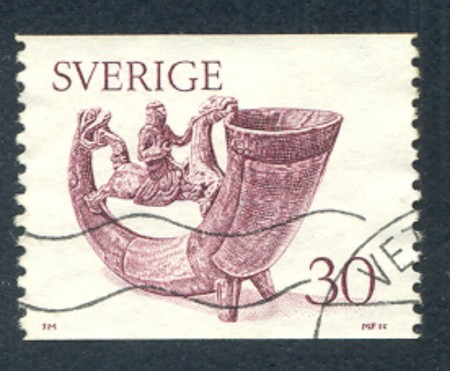
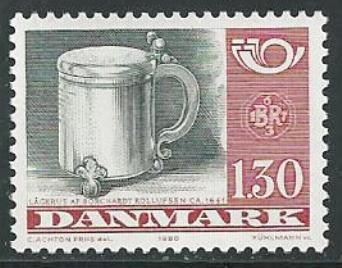 \
\ 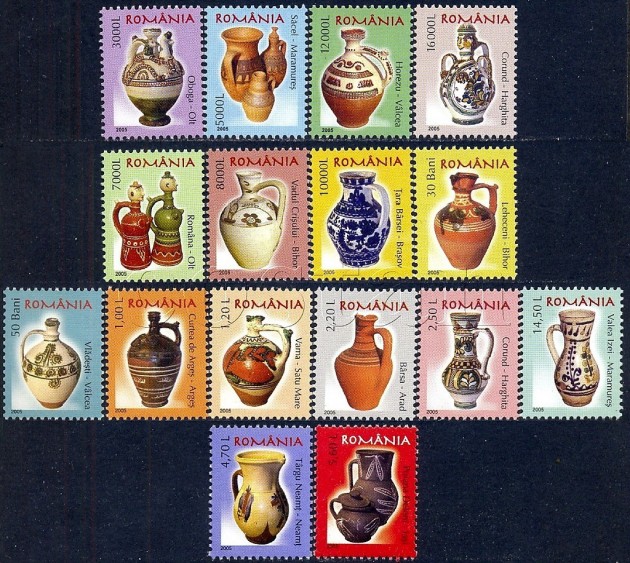
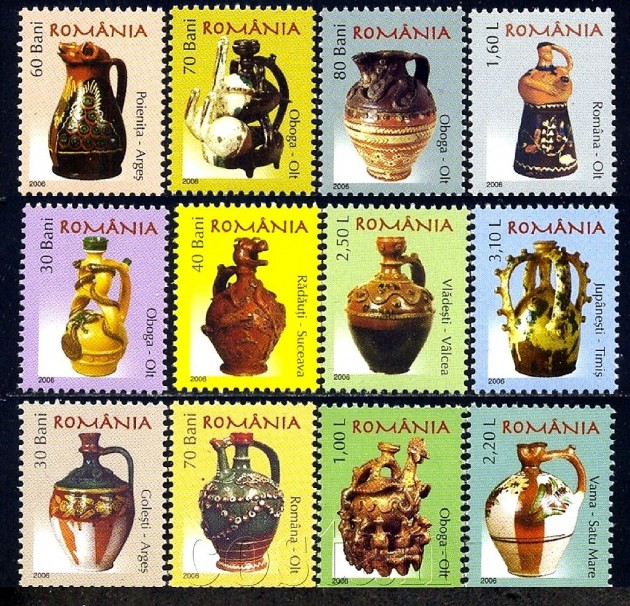
![Rsos - wedding cup on stamps HAVE IT POSTED [Q]](http://www.steveonsteins.com/wp-content/uploads/2013/06/Rsos-wedding-cup-on-stamps-HAVE-IT-POSTED-Q-630x285.jpg) ▲ Antique German .800 silver silver wedding cups on stamps. For more info See: http://www.steveonsteins.com/wedding-cups also see: Wager cups : http://www.steveonsteins.com/windmill-cups-these-are-wager-cups-new-8-25-2012
▲ Antique German .800 silver silver wedding cups on stamps. For more info See: http://www.steveonsteins.com/wedding-cups also see: Wager cups : http://www.steveonsteins.com/windmill-cups-these-are-wager-cups-new-8-25-2012 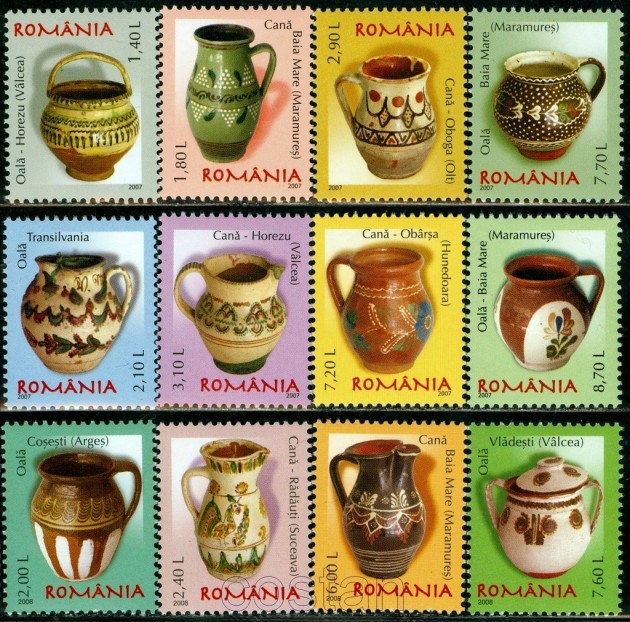
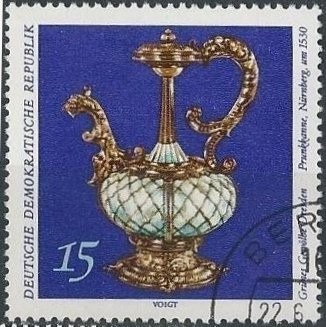
Stanhope – A very tiny photograph stuck between a magnifying glass and a piece of clear glass backing. It is named for it’s inventor. These were very popular in Europe and many of Reservist steins were ordered with one. Shown: The “Stanhope,” used to represent the Lion’s eye on a Bavarian Infantry Reservist stein, is now missing. Some can be found with one of the two glasses still intact in the thumblifts, however the photo scenes are missing due to a previous (dumb-assed) owner washing the stein. See email in “Answers to questions ” about this subject: http://www.steveonsteins.com/answers-to-questions-of-note also see: http://www.foxauctionsonline.com/Stanhopes.pdf.
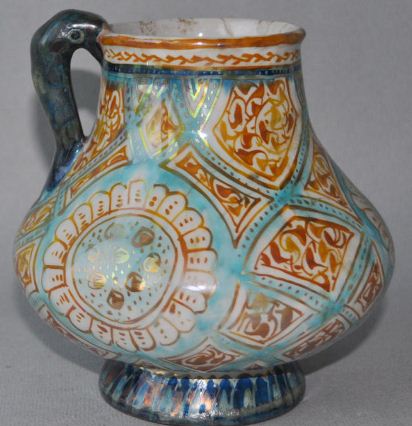
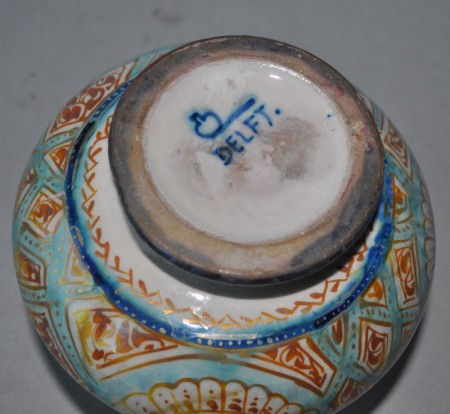
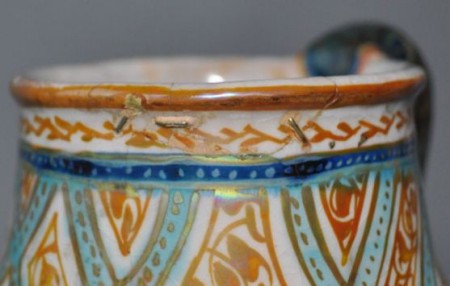 Detail
Detail
Stapled repair – A old time European method of strengthening a pottery (or other material) repair by forcing metal (copper usually) staples into the ceramic and then gluing everything in place to prevent leaks. This is an indicator that the drinking vessel meant a lot to the family (or like with your editor, they were just broke as hell and could not afford a new one!)
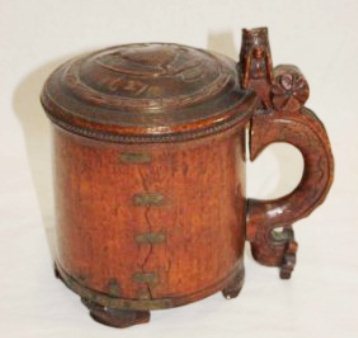
Scandinavian wooden stein repair with larger than usual staples.
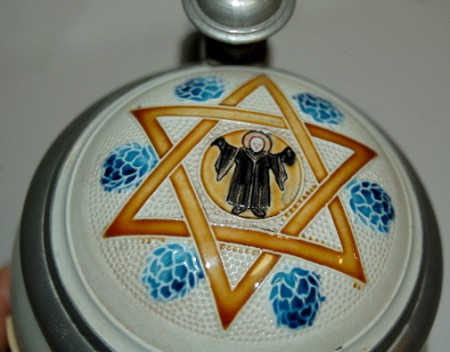 Star of David [Not in this case.] – See: “Six sided star” on this page, above.
Star of David [Not in this case.] – See: “Six sided star” on this page, above.
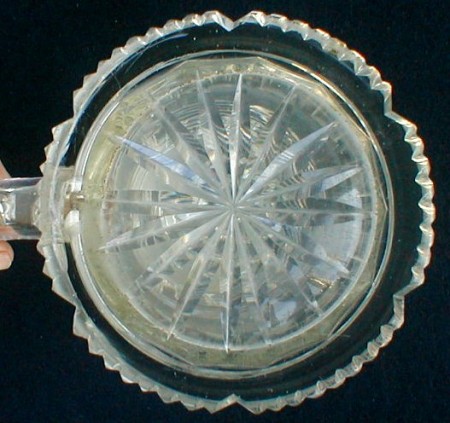 Star cut base -A popular decoration on the bottom of Bohemian / Silesian blown and cut glass steins from the period of about 1820 – 1860. Shown above: A “16 point” cut star in the base of the glass stein shown just below. Also see “Sun Burst”pattern.
Star cut base -A popular decoration on the bottom of Bohemian / Silesian blown and cut glass steins from the period of about 1820 – 1860. Shown above: A “16 point” cut star in the base of the glass stein shown just below. Also see “Sun Burst”pattern.
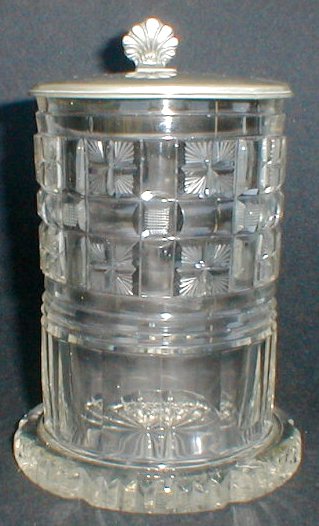
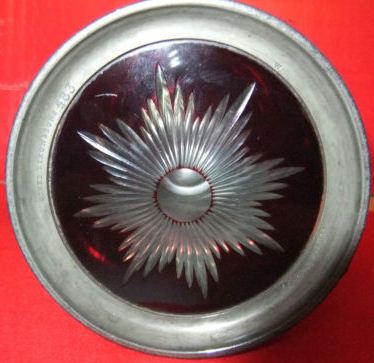 Another type of star burst cutting, on a James Dixon and Sons English pewter college tankard dated 1861.
Another type of star burst cutting, on a James Dixon and Sons English pewter college tankard dated 1861.
State stripes / colors – Small colored indicator ribbons on Reservist steins, located on both the upper and lower ribs above and below the main scene. These colors indicate the unique color combination assigned to each German state in the Imperial German Army. Knowledge of these stripes may be useful in determining the newer types of reservist reproduction steins that almost always have the flat Baden Griffin as a thumblift. Below are the ribbon stripes and the states they represent (I have also added the most predominant thumblift found from these states): White and Blue …Bavaria…… .Rampant Lion holding a shield, sometimes cross hatched, sometimes the same as on Hesse steins. Red and White …Hesse…………Rampant Lion with a shield that is never cross hatched. Red and Black… .Wurttemburg…A flat coat of arms with deer supporters, and if from the city of Ulm, a wren. Red and Yellow… Baden …… .A flat Griffin holding the coat of arms. Green and White….Saxony……….A flat coat of arms with a curved sash going from left top to lower right. White and Black…Prussia…… A spread winged eagle. Black, White and Red (No state per se, but under Imperial control. An eagle with wings on body and crowned Note: other specialized thumblifts are found that have no relationship to the German state. For example: St. Barbara can be on Artillery steins; winged wheels are on Eisenbahn (railroad) units; horse heads are found on Blacksmith and certain other horse units.
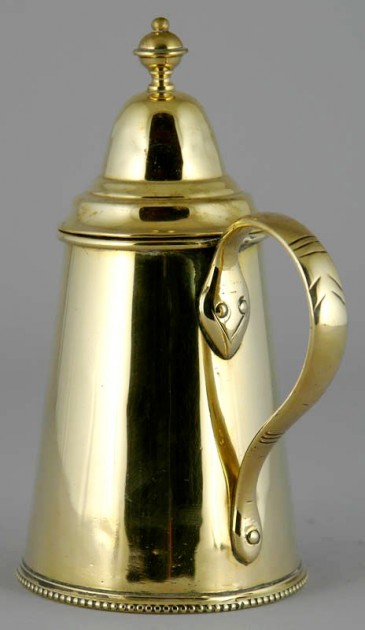 Steeple top / lid – Fairly explanatory. Shown” a great old (Early 1800’s) English Quart tankard , with a set-on lid stein and a steeple top. Shown: 7 5/8th inches tall. [W.P’s — for sale on eBay, 6-2011 – a very nice looking stein.] Stein – [1] The biggest “misnomer” of all in beer stein collecting! The word means “stone” in German. The English speakers got it from “Steinzeug,” or “stoneware” in German. [2] A drinking vessel called a tankard anywhere else in the whole world EXCEPT the USA! Stein Collector’s International (SCI) – http://www.steincollectors.org/ Their stated and published purpose is: “Stein Collectors International is a non-profit, member owned and operated organization dedicated to advancing the state of knowledge and the appreciation of beer steins and other drinking vessels.” What a joke!! It is one of the most dysfunctional collector’s organization I have ever seen. I say: Join only for the magazine = “PROSIT.” Should you wish more information, just email me =”thevirginian@cox,net
Steeple top / lid – Fairly explanatory. Shown” a great old (Early 1800’s) English Quart tankard , with a set-on lid stein and a steeple top. Shown: 7 5/8th inches tall. [W.P’s — for sale on eBay, 6-2011 – a very nice looking stein.] Stein – [1] The biggest “misnomer” of all in beer stein collecting! The word means “stone” in German. The English speakers got it from “Steinzeug,” or “stoneware” in German. [2] A drinking vessel called a tankard anywhere else in the whole world EXCEPT the USA! Stein Collector’s International (SCI) – http://www.steincollectors.org/ Their stated and published purpose is: “Stein Collectors International is a non-profit, member owned and operated organization dedicated to advancing the state of knowledge and the appreciation of beer steins and other drinking vessels.” What a joke!! It is one of the most dysfunctional collector’s organization I have ever seen. I say: Join only for the magazine = “PROSIT.” Should you wish more information, just email me =”thevirginian@cox,net
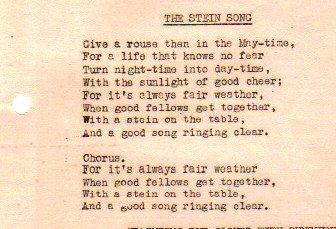 Stein Song, The – An old drinking song. Shown: Copy of original typed formatted song. Needs to be blown up to read.
Stein Song, The – An old drinking song. Shown: Copy of original typed formatted song. Needs to be blown up to read.
Steingut – A rather imprecise term for a usually light-colored porous ceramic with a hardness dependent upon the temperature of the firing, from 960°C (1800°F) to 1300°C (2350°F); generally used to include all tan-colored ceramic materials.
Steinologist – See Master Steinologist.
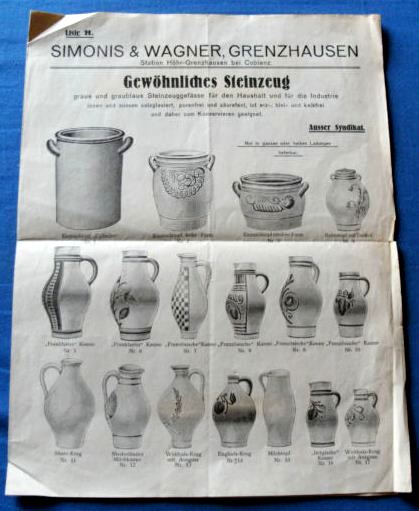 Steinzeug (Germ.) – Stoneware. Shown ▲: A Ca. 1900’s catalog page showing various older forms of pear jugs and others that could be still ordered then. Steinzeugwerke – This was a joint effort of several stein makers to fight off the worsening economic conditions in Germany by 1910. Steinzeugwerke was a sales consortium, located in Höhr & Grenzhausen, in the Westerwald area of old Germany. Created and directed by Paul Merkelbach in 1910/1911, it consisted of Simon Peter Gerz I, Reinhold Hanke, Reinhold Merkelbach & Walter Müller. Out of business by sometime after 1918. For more info see: http://steincollectors.org/_disc08/00000236.htm STEINZEUGWERKE # 1314 – 2 LITER – BEER STEIN GERMAN – PRE WWI NICE
Steinzeug (Germ.) – Stoneware. Shown ▲: A Ca. 1900’s catalog page showing various older forms of pear jugs and others that could be still ordered then. Steinzeugwerke – This was a joint effort of several stein makers to fight off the worsening economic conditions in Germany by 1910. Steinzeugwerke was a sales consortium, located in Höhr & Grenzhausen, in the Westerwald area of old Germany. Created and directed by Paul Merkelbach in 1910/1911, it consisted of Simon Peter Gerz I, Reinhold Hanke, Reinhold Merkelbach & Walter Müller. Out of business by sometime after 1918. For more info see: http://steincollectors.org/_disc08/00000236.htm STEINZEUGWERKE # 1314 – 2 LITER – BEER STEIN GERMAN – PRE WWI NICE 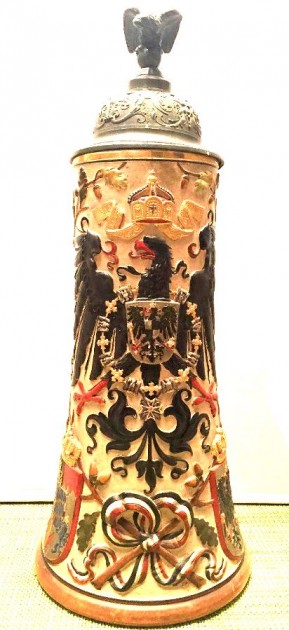
Stemciled i.d. ▼ A kinder mug PROBABLY A GIVE AWAY WITH STENCILED AD ON BOTTOM – UNU 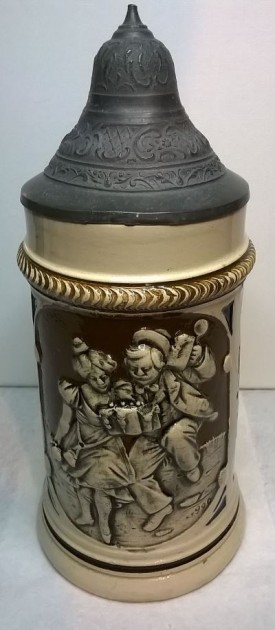
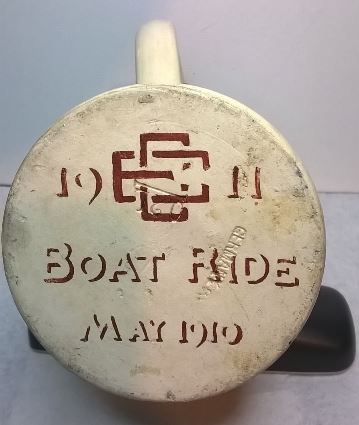
Sterling – Silver made that is .925 / 1000th pure silver, the rest being copper. It has been the standard in England since the 1500’s and in American (by practice and not law) since 1865 when the Gorham Silver Co. started using “Sterling.” This did finally become the US standard, set by the United States Government by the Stamping Act of 1906, and any article stamped “Sterling” is supposed to be of assured quality. Note: Other countries have different National Silver Standards. Germany’s has been 800 / 1000th, since 1888. See the tab this web site : “A review of European silver quality marks,” http://www.steveonsteins.com/a-review-of-european-silver-quality-marks-and-photos-ok
STEVENS & WILLIAMS – Very popular Makers of art glass , Stevens & Williams of Stourbridge, England, made many types of glass, including layered, etched, cameo, and art glass, between the 1830s and 1930s. Some pieces are signed S & W. Many pieces are decorated with flowers, leaves, and other designs based on nature. ▼A ruby stain over a citrine wine server excellent design — I wish I owned it
. 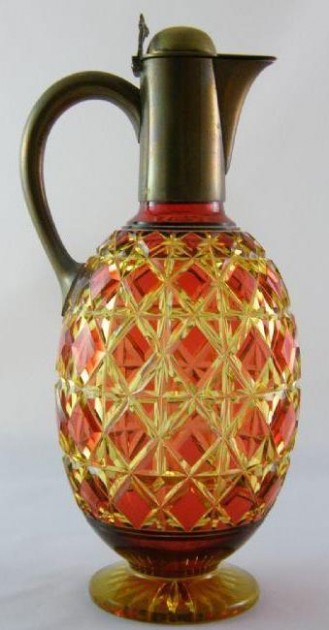
Stickley Brothers – Makers of nicely done copper work in the Arts and Crafts period.
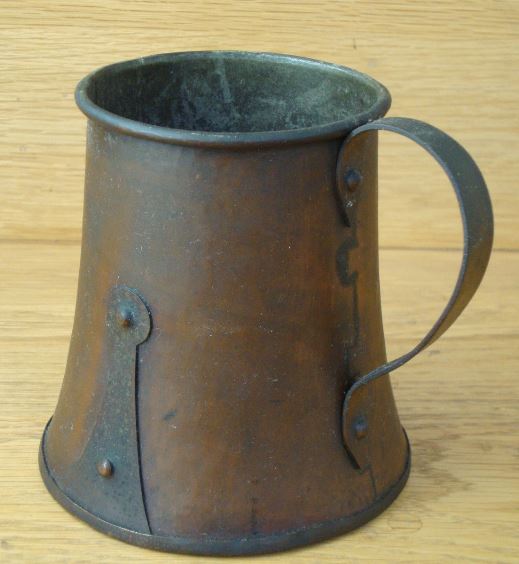 The above mug very much interests me as it looks at first glance to be Russian made given the rolled lip and the heart on the handle
The above mug very much interests me as it looks at first glance to be Russian made given the rolled lip and the heart on the handle
bottom finial. For comparison of that style see: http://www.steveonsteins.com/russian-antique-copper-vessels
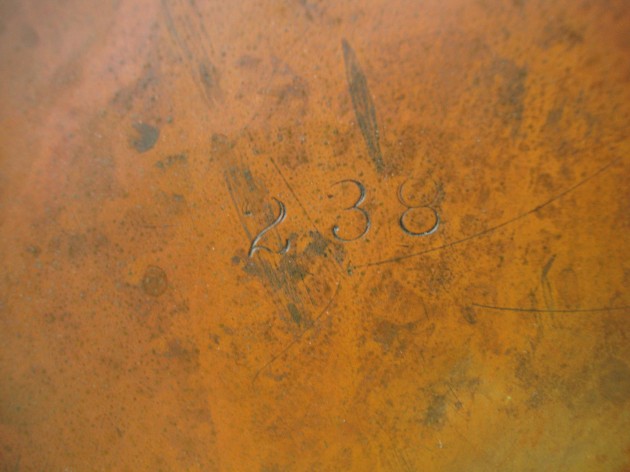 Mold No. stamp for above mug.
Mold No. stamp for above mug.
Stien; also steine, and stine. – Alternative spellings of “stein” .found in great profusion on eBay and Etsy type web sites. New collectors should sometimes search for steins under theses spellings as there are a lot of dumb assed sellers out there that still sell using these misspelled words. There were 203 entries [posts] for “Stien” on eBay the day I posted this definition.
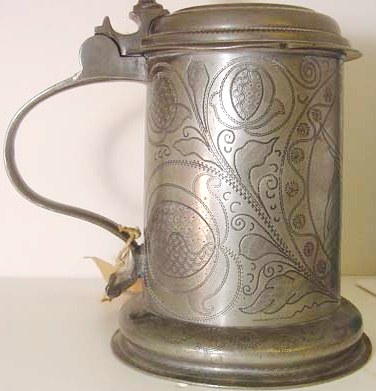
Stippling – Tiny dots struck in the surface of a vessel to give detail to an engraved pattern. To render dates, initials and occasionally coats of arms and longer inscriptions, simply by using a hammer and a punch. Shown above: Stippling and wriggle work on a Baltic states pewter stein. Circa 1750 (Perhaps= ?? There is not much wear showing from this photo. This would be a case where it has to be held and looked at closely to be evaluated correctly!
Stirrup cup – “Cup” is the misnomer here as “it (the cup)” normally has no handle. These were 99% beakers that get their name from the practice of handing one to riders either while they stayed on their saddles at an Inn, or for a goodbye drink upon leaving a friend’s home on one’s horse. Shown: 4 inch long Russian silver dated 1896. See http://www.steveonsteins.com/stirrup-cups-the-little-gems-of-thirst-quenchers
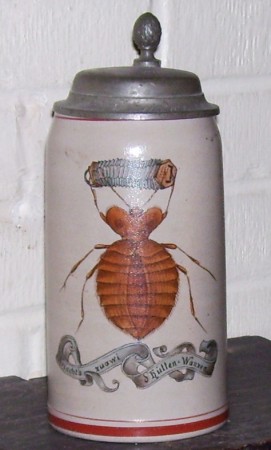
Stoneware – A true vitrified ceramic, but lacking the fine white color and translucency of porcelain. Made in a process of adding regular salt into the heated kiln fired at 1100°C-1300°C. that process makes it hard and impermeable after firing. Stoneware has been made in the Rhine valley in Germany as early as the 15th century. Also know as “Saltglazed Stoneware.” The Westerwald area of Germany is now the most famous area for producing this ware, although many other areas did also. Shown: A typical one liter stoneware “krug” that has an enameled scene on the body and then an artificial clear glaze applied over the handpainting. For details on the stein shown above: See the tab this web site: “The bed bug story.” = http://www.steveonsteins.com/the-bed-bug-story-a-quicky There is now a newer German “salt glazed induced finish.” That means it was done RECENTLY after the German Government imposed restriction on the use of the old slat glazing techniques due to the acid air that that process makes. Also here a very good beginners article by Herr J. Vogt: http://www.beerstein.net/articles/bsj-1c.htm ▼ Westerwald stoneware –
A 15 in tall showing the Electors of Germany in relief. C. 1885 -95.
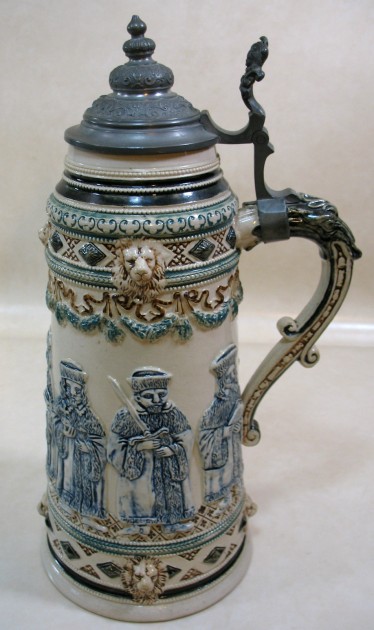
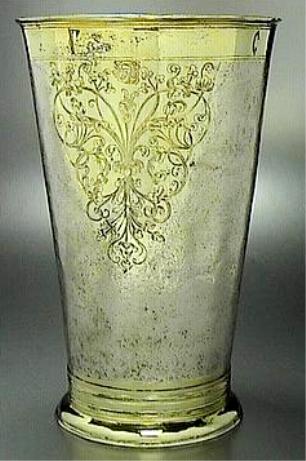
Stopa – A Russian form of a very large beaker with wide top, in silver and silver plate; these probably originated in the Baltic States first. Shown ▲: A 2009 sale: 3-8th inches c. 1680
sold for $22,000.
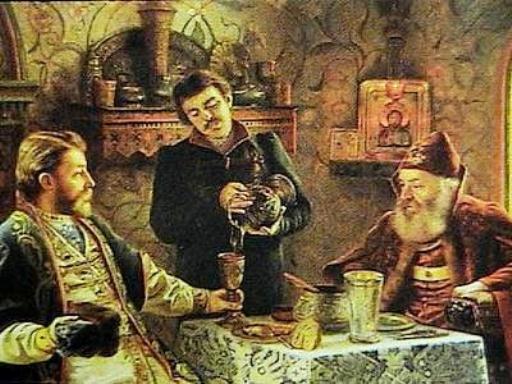
The older Boyar is enjoying his drink from a silver Stopa.
Stork stein (Also called “The Babies Stein”) – Storks resting on top of a chimney in Germany were thought to bring good luck! Of course the story of the stork bringing the baby was a popular fable too. Shown: A “very popular” colorful pottery relief stein, Circa 1890. The German interp reads something like: “The flapper stork’s inspected inventory.” Each child (or twins) has an associated occupation attached to it. [TSACO]
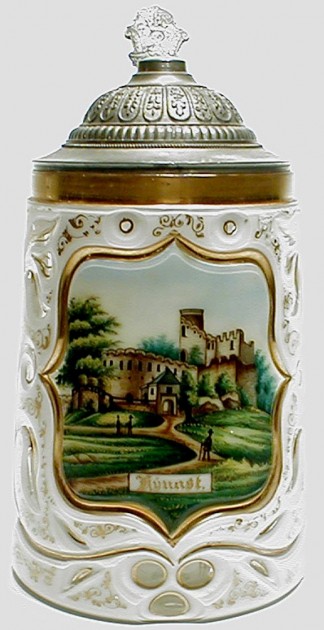
Strap repair – A “B-S” term used by the US stein auctioneers to not describe a replaced lid, even though that phrase is printed on their “definitions” page (which who really reads?) There have been 4 US pewter smith’s (that just I know of personally) in the last 4 decades placing old lids on steins that didn’t have ones originally, or when the owner wanted a lid changed. Some old steins really do have strap repairs, most often around the side of handle due to use and are very apparent. Shown: A pewter relief lid, which appeared to be a lid from a V & B Mettlach, #1526 stein, (Circa 1900) added to a very nice Josephinenhütte glass beer mug. Circa 1860. Something like this might be called as a “strap repair” under the US stein auctioneers catalog definitions, although this is such a bad mix, (mis-fit) that they might be forced to call this what it is: an added old lid!
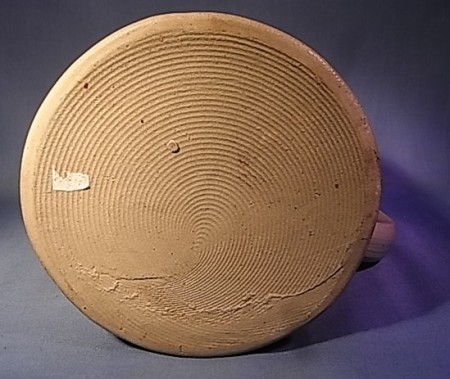
String cut base – When a potter removes a stein off a wheel he will use a string and it leave a distinct mark on the bottom as shown in photo. Most “very” early pottery and stoneware stein bases were washed smooth.
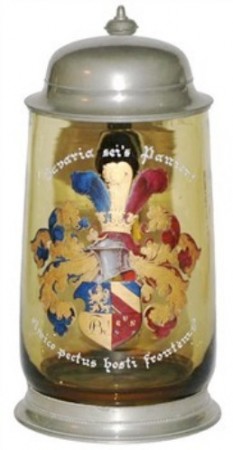
Student society steins -Because of the brightly enameled Coat of Arms for the different societies (and there are many.) These are a very collectable “sub-set” of beer steins. The Germans love them, and the study of the Coat of Arms (not crests) can be fascinating. Shown ▲: A Theresienthal glass stein, probably enameled by a decorator’s firm such as van Hauten’s. Also see “Dueling” in this site’s Compendium.
Stueler, George & Hans –Name stamped on this “Trumpeter of Sackingen” .25 liter pottery relief kinder stein. Distributors / Brewers? Ca. 1917-1931. See: http://www.steinmarks.co.uk/pages/pv.asp?p=stein1
Sulzbach 1752-1774- City or town of major fayence stein production.
Summa – (“S’ as in ” S 1/2 L”) – The “S” standing for the Latin: “Summa [or] Summe” [sum = total.] This is part of the capacity mark found on early “mud” (modell) steins. Used before the makers all agreed to use the 1/2 L designation. Also: “J” (interchangeable with I), when found stamped about the rim of an older stoneware steins (mostly the modell steins from the Westerwald, this is also part of the signification of measurement. It is the abbreviation of the old German word for ‘Inhalt” which means ‘capacity. So if one sees: 1/2 L J, it means one half a liter capacity. (Thanks to Roy DeSelms, Prosit, 12-2010.)
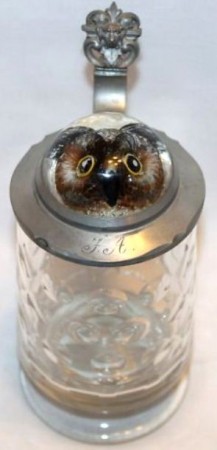 Sulphides (art) stein lids – Well not really, just inversed pressed relief lids that were enameled. For more info on real sulphides please see: http://paperweights.cristallerie-hartwig.com/history.html
Sulphides (art) stein lids – Well not really, just inversed pressed relief lids that were enameled. For more info on real sulphides please see: http://paperweights.cristallerie-hartwig.com/history.html
Sunburst cutting pattern – stein base – Found on early Bohemian glass steins, one of many patterns. SEE: Star cut base.
S.W.A.G. – A Scientific Wild Ass Guess. An announced decision that is based on years of knowledge or exposure to a subject but with no published or formal references for one’s decision. I believe that when this is done by most long term and respected collectors about a beer stein, with a through review of all the descriptive info and with good photos, SWAG’s will be probably about 75 to 85% correct. (QUALIFYING NOTE: This blue note above does not apply to so called collectors that run stein information sites for money especially on the East Coast! These people couldn’t care less about retaining correct information to start with and have been know to render some really ludicrous decisions in the past!)
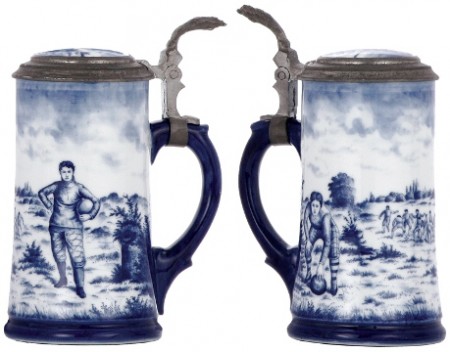 Swain & C0. – Large maker of” Blue Onion and “Delft-ware” steins . Shown: Porcelain stein, .5L, marked Delft, by Swaine and Co., Hüttensteinach and Köppelsdorf. Thuringia. A Rugby Game, inlaid lid, with a lithophane. See: http://www.steinmarks.co.uk/pages/pv.asp?p=stein1
Swain & C0. – Large maker of” Blue Onion and “Delft-ware” steins . Shown: Porcelain stein, .5L, marked Delft, by Swaine and Co., Hüttensteinach and Köppelsdorf. Thuringia. A Rugby Game, inlaid lid, with a lithophane. See: http://www.steinmarks.co.uk/pages/pv.asp?p=stein1

Swedish steins – Any ‘Three Crowns” mark, is usually from Sweden’s Coat of Arms. For the origin of The Three Crowns please see an interesting article at: http://www.ryderantiques.com/ Shown: A large “Daubenkrug” (Germ.) made by F. Santesson in Stockholm. Ca 1890. with the National Arms. [S.C.] For more on Santesson please see: http://www.steveonsteins.com/f-santesssons-till-eulenspiegels-daubenkrug-new-9-6-11
Swedish silver and pewter date marks: Below are the Date Letter Marks 1759 – 1974 ▼. [Years 1694 to 1758 used a different type of script every 24 years (which I can not duplicate with my set of “Alt Codes.”)
A = 1759 B = 1760 ” ” “ Y = 1781 Z = 1782 A 2 = 1783 B 2 = 1784 ” ” “ Y 2 = 1805 Z 2 = 1806 A 3 = 1807 B 3 = 1808 ” ” “ Y 3 = 1829 Z 3 = 1830 A 4 = 1831 B 4 = 1832 ” ” “ Y 4 = 1853 Z 4 = 1854 A 5 = 1855 B 5 = 1856 ” ” “ Y 5 = 1877 Z 5 = 1878 A 6 = 1879 B 6 = 1880 ” ” “ Y 6 = 1901 Z 6 = 1902 A 7 =1903 B 7 =1904 ” ” “ Y 7 = 1925 X 7 = 1926 A 8 = 1927 B 8 = 1928 ” ” “ Y 8 = 1949 Z 8 = 1950 A 9 = 1951 B 9 = 1952 ” ” “ Y 9 = 1973 Z 9 = 1974
Swirled glass– Usually a swirled design of different colored glass inlayed within two clear glass layers. A very hard technique for a glass blower to learn, therefore the steins are usually expensive! Shown▼: A rare Bohemian swirled glass, over one liter. Circa 1820 -30 [FWTD]
![(- BOHEMIAN SWIRLED GLASS CA 1820 DO I HAVE THIS UNDER SWIRL [Q]](http://www.steveonsteins.com/wp-content/uploads/2011/06/BOHEMIAN-SWIRLED-GLASS-CA-1820-DO-I-HAVE-THIS-UNDER-SWIRL-Q.jpg)
![(- BOHEMIAN SWIRLED GLASS CA 1820 DO I HAVE THIS UNDER SWIRL [Q]](http://www.steveonsteins.com/wp-content/uploads/2011/06/BOHEMIAN-SWIRLED-GLASS-CA-1820-DO-I-HAVE-THIS-UNDER-SWIRL-Q.jpg)
.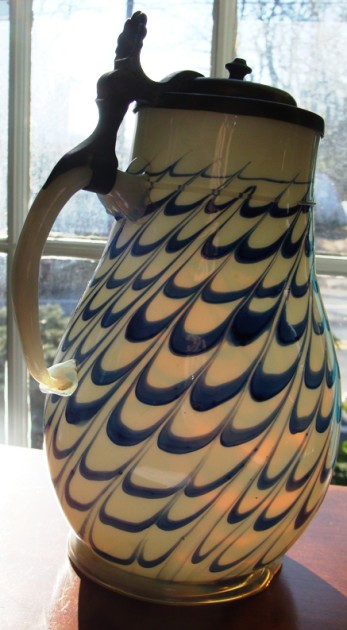 Swirled blue glass inside a “Milk Glass” stein from the 1700’s. Not cheap at all! [JS]
Swirled blue glass inside a “Milk Glass” stein from the 1700’s. Not cheap at all! [JS]
Symbols, drinking, on beer steins – Cat = a [bad] hangover; Herring = hangover food; Monkey (on your back) = drunkenness/ acting drunk.
Symbols, religious – Collectors of old steins will find various religious symbols either painted or engraved on the surface. This is especially true of Ruby stained steins from Bohemian in the mid 1800’s Please go to this page for many pictorial examples: http://www.steveonsteins.com/ruby-cut-to-clear-fellowship-symbols-1
The following are the definitions of some of the most common religious symbols used around the world: Some can be found on mostly older German beer steins. • Anchor/Ships — Hope or Seafaring profession • Angel, Flying- Rebirth; Resurrection. • Angel, Trumpeting- Resurrection. • Angel, Weeping- Grief and Mourning. • Arch – Victory in death. • Arrow- Mortality. • Bird- Eternal life. • Bird, Flying- Resurrection. • Book-Representation of a holy book: i.e. the Bible. • Breasts (Gourds, Pomegranates) – Nourishment of the soul; the church. • Bouquets/Flowers — Condolences, grief, sorrow • Broken Column — Loss of Head of Family • Broken Ring — Family Circle Severed • Buds/Rosebud — Morning of Life or Renewal of Life • Bugles — Resurrection and the Military • Butterfly — Short-lived – Early Death • Candle being Snuffed — Time, mortality • Cherub — Angelic • Coffin, Father Time, Picks/Shovels, Darts — Mortality • Columns and Doors- Heavenly entrance. • Corn — Ripe Old Age • Cross — Emblem of Faith • Crossed Swords — High-ranking military person • Crown- Glory of life after death. • Cup or Chalice- The Sacraments. • Dove- Purity; Devotion. • Dove, Flying- Resurrection. • Drapes- Mourning; Mortality. • Flame or Light- Life; Resurrection. • Flower- Fragility of life. • Flower, Severed Stem- Shortened life. • Flying Birds — Flight of the Soul • Fruits — Eternal plenty • Full-Blown Rose — Prime of Life • Garland or Wreath- Victory in death. • Grim Reaper- Death personified. • Hand, Pointing Up- Pathway to heaven; Heavenly reward. • Hands, Clasped- The goodbyes said at death. • Hand of God Chopping — Sudden Death • Handshakes – Farewell, also indicates marriage. • Harp — Praise to the Maker • Heart- Love; Love of God; Abode of the soul; Mortality. • Horns — The Resurrection • Hourglass- Passing of time. • Hourglass, Flying- Time flies. • Imps — Mortality • Ivy — Friendship and Immortality • Lamb- Innocence. • Laurel —Fame or Victory • Lily or Lily of Valley — Emblem of Innocence and Purity • Lion- Courage; The Lion of Judah. • Morning Glory — Beginning of Life • Oak Leaves and Acorn — Maturity, Ripe Old Age • Open Book/ Bible — Deceased Teacher, Minister, etc. • Pall- Mortality. • Palm Branch — Signifies Victory and Rejoicing • Pick- Death; Mortality. • Poppy — Sleep • Portals — Passageway to eternal journey • Rod or Staff- Comfort for the bereaved. • Rooster- Awakening; Resurrection. • Roses — Brevity of earthly existence • Scythe- Death; The divine harvest. • Seashell- Resurrection; Life everlasting; Life’s pilgrimage. • Sheaf of Wheat — Ripe for Harvest, Divine Harvest, Time • Skull- Mortality. • Skull/ Crossed Bones- Death. • Skeleton- Life’s brevity. • Snake (Tail in Mouth)- Everlasting life in heaven. • Spade- Mortality; Death. * Stag – Friendship, extreme caring, love. • Stars and Stripes Around Eagle — Eternal Vigilance, Liberty • Sun Rising- Renewed life. • Sun Shining-Life everlasting. • Sun Setting- Death. • Thistle- Scottish descent. • Thistles — Remembrance • Tombs — Mortality • Torch Inverted — Life Extinct • Tree- Life. • Tree Sprouting- Life everlasting. • Severed Branch- Mortality. • Tree Stump- Life interrupted. • Tree Stump w/Ivy — Head of Family – Immortality • Tree Trunk- Brevity of life. • Tree Trunk Leaning- Short interrupted life. • Trumpeters — Heralds of the Resurrection • Urn- Immortality (ancient Egyptian belief that life would be restored in the future through the vital organs placed in the urn). • Urn with /Wreath or Crepe — Mourning • Urn with Blaze — Undying Friendship • Weeping Willow Tree- Mourning; Grief; Nature’s lament. • Willows — Earthly Sorrow • Winged Face- Effigy of the deceased soul; the soul in flight. • Winged Skull- Flight of the soul from mortal man. •
Wreath- Victory. •
Wreath on Skull- Victory of death over life. •
Wheat Strands or Sheaves- The divine harvest.
[END – SNOTOK – 67 (plus stamps) – R5] WISH TO CONTACT ME, STEVE (STEPHEN) ? =  “Drink coffee! Do stupid things faster with more energy!”
“Drink coffee! Do stupid things faster with more energy!”

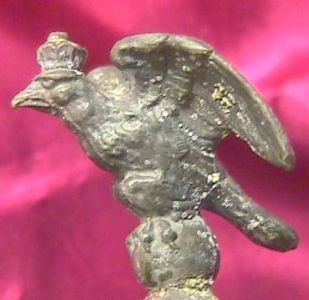
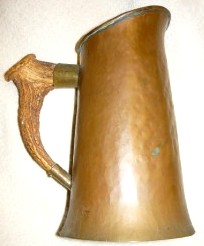
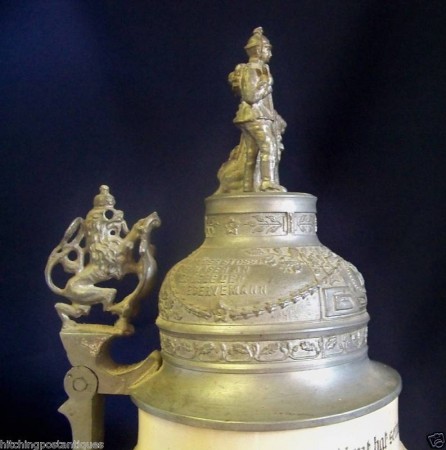
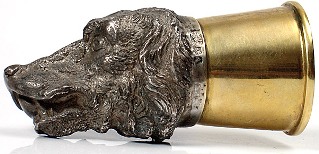
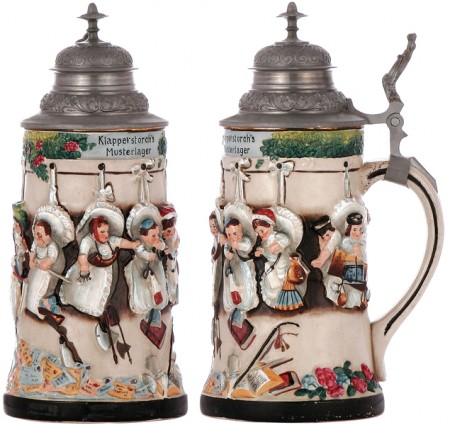

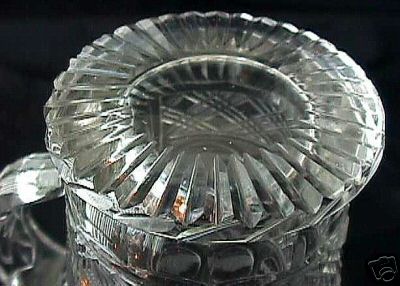
Leave a Reply